
Sewerage is the infrastructure that conveys sewage or surface runoff using sewers. It encompasses components such as receiving drains, manholes, pumping stations, storm overflows, and screening chambers of the combined sewer or sanitary sewer. Sewerage ends at the entry to a sewage treatment plant or at the point of discharge into the environment. It is the system of pipes, chambers, manholes or inspection chamber, etc. that conveys the sewage or storm water.

An outhouse is a small structure, separate from a main building, which covers a toilet. This is typically either a pit latrine or a bucket toilet, but other forms of dry (non-flushing) toilets may be encountered. The term may also be used to denote the toilet itself, not just the structure.

A composting toilet is a type of dry toilet that treats human waste by a biological process called composting. This process leads to the decomposition of organic matter and turns human waste into compost-like material. Composting is carried out by microorganisms under controlled aerobic conditions. Most composting toilets use no water for flushing and are therefore called "dry toilets".

Night soil is a historically used euphemism for human excreta collected from cesspools, privies, pail closets, pit latrines, privy middens, septic tanks, etc. This material was removed from the immediate area, usually at night, by workers employed in this trade. Sometimes it could be transported out of towns and sold on as a fertilizer.
Human waste refers to the waste products of the human digestive system, menses, and human metabolism including urine and feces. As part of a sanitation system that is in place, human waste is collected, transported, treated and disposed of or reused by one method or another, depending on the type of toilet being used, ability by the users to pay for services and other factors. Fecal sludge management is used to deal with fecal matter collected in on-site sanitation systems such as pit latrines and septic tanks.

Cesspit, cesspool and soak pit in some contexts are terms with various meanings: they are used to describe either an underground holding tank or a soak pit. A cesspit can be used for the temporary collection and storage of feces, excreta or fecal sludge as part of an on-site sanitation system and has some similarities with septic tanks or with soak pits. Traditionally, it was a deep cylindrical chamber dug into the ground, having approximate dimensions of 1 metre (3') diameter and 2–3 metres depth. Their appearance was similar to that of a hand-dug water well.

A bucket toilet is a basic form of a dry toilet whereby a bucket (pail) is used to collect excreta. Usually, feces and urine are collected together in the same bucket, leading to odor issues. The bucket may be situated inside a dwelling, or in a nearby small structure.
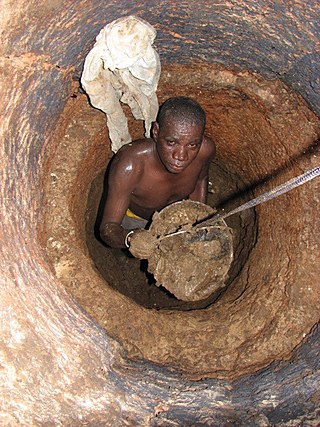
Manual scavenging is a term used mainly in India for "manually cleaning, carrying, disposing of, or otherwise handling, human excreta in an insanitary latrine or in an open drain or sewer or in a septic tank or a pit". Manual scavengers usually use hand tools such as buckets, brooms and shovels. The workers have to move the excreta, using brooms and tin plates, into baskets, which they carry to disposal locations sometimes several kilometers away. The practice of employing human labour for cleaning of sewers and septic tanks is also prevalent in Bangladesh and Pakistan. These sanitation workers, called "manual scavengers", rarely have any personal protective equipment. The work is regarded as a dehumanizing practice.

A pig toilet is a simple type of dry toilet consisting of an outhouse mounted over a pigsty, with a chute or hole connecting the two. The pigs consume the feces of the users of the toilet, as well as other food.
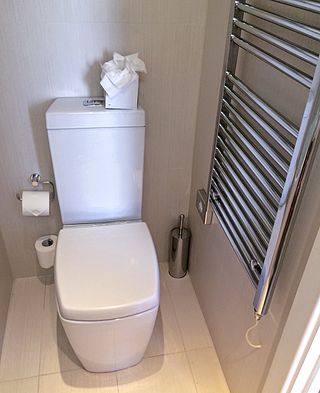
A toilet is a piece of sanitary hardware that collects human urine and feces, and sometimes toilet paper, usually for disposal. Flush toilets use water, while dry or non-flush toilets do not. They can be designed for a sitting position popular in Europe and North America with a toilet seat, with additional considerations for those with disabilities, or for a squatting posture more popular in Asia, known as a squat toilet. In urban areas, flush toilets are usually connected to a sewer system; in isolated areas, to a septic tank. The waste is known as blackwater and the combined effluent, including other sources, is sewage. Dry toilets are connected to a pit, removable container, composting chamber, or other storage and treatment device, including urine diversion with a urine-diverting toilet.

A sanitation worker is a person responsible for cleaning, maintaining, operating, or emptying the equipment or technology at any step of the sanitation chain. This is the definition used in the narrower sense within the WASH sector. More broadly speaking, sanitation workers may also be involved in cleaning streets, parks, public spaces, sewers, stormwater drains, and public toilets. Another definition is: "The moment an individual’s waste is outsourced to another, it becomes sanitation work." Some organizations use the term specifically for municipal solid waste collectors, whereas others exclude the workers involved in management of solid waste sector from its definition.
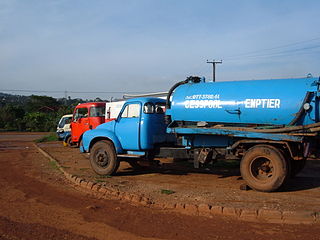
A vacuum truck, vacuum tanker, vactor truck, vactor, vac-con truck, vac-con is a tank truck that has a pump and a tank. The pump is designed to pneumatically suck liquids, sludges, slurries, or the like from a location into the tank of the truck. The objective is to enable transport of the liquid material via road to another location. Vacuum trucks transport the collected material to a treatment or disposal site, for example a sewage treatment plant.
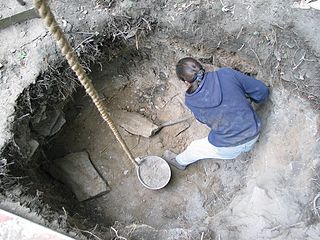
Privy digging is the process of locating and investigating the contents of defunct outhouse vaults. The purpose of privy digging is the salvage of antique bottles and everyday household artifacts from the past. Privy digging is a form of historical digging and is often conducted on private residential properties. Construction sites and major developments around older areas of towns and cities are also likely places to look for evidence of privies.

A pail closet or pail privy or dirt closet was a room used for the disposal of human excreta, under the "pail system" of waste removal. The "closet" was a small outhouse (privy) which contained a seat, underneath which a portable receptacle was placed. This bucket (pail), into which the user would defecate, was removed and emptied by the local authority on a regular basis. The contents, known euphemistically as night soil, would either be incinerated or composted into fertiliser.

Bezwada Wilson is an Indian activist and one of the founders and National Convenor of the Safai Karmachari Andolan (SKA), an Indian human rights organization that has been campaigning for the eradication of manual scavenging, the construction, operation and employment of manual scavengers which has been illegal in India since 1993. His work at SKA, a community-driven movement, has been recognized by the Ashoka Foundation which has nominated him a Senior Fellow. On 27 July 2016, he was honoured with the Ramon Magsaysay Award. He is an Ambedkarite.
The privy midden was a toilet system that consisted of a privy (outhouse) associated with a midden. They were widely used in rapidly expanding industrial cities such as Manchester in England, but were difficult to empty and clean. A typical comment was that they were of "most objectionable construction" and "usually wet and very foul". They were replaced eventually by pail closets and flush toilets. Similar systems still exist in some developing countries, but the term "privy midden" is now an archaism.
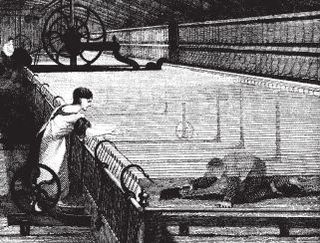
Scavengers were employed in 18th and 19th century in cotton mills, predominantly in the UK and the United States, to clean and recoup the area underneath a spinning mule. The cotton wastage that gathered on the floor was seen as too valuable for the owners to leave and one of the simplest solutions was to employ young children to work under the machinery. Many children suffered serious injuries while under the mules, with fingers, hands, and sometimes heads crushed by the heavy moving parts. Legislation introduced in 1819 tried to reduce working hours and improve conditions but there were still deaths recorded well beyond the middle of the 19th century.
A toilet god is a deity associated with latrines and toilets. Belief in toilet gods – a type of household deity – has been known from both modern and ancient cultures, ranging from Japan to ancient Rome. Such deities have been associated with health, well-being and fertility and have been propitiated in a wide variety of ways, including making offerings, invoking and appeasing them through prayers, meditating and carrying out ritual actions such as clearing one's throat before entering or even biting the latrine to transfer spiritual forces back to the god.
A bayakou is a sanitation worker who works to empty the fecal sludge out of pit latrines in Haiti, especially in larger cities, such as Port-au-Prince. The word bayakou comes from Haitian Creole. Bayakou are subjected to social stigma for their work in manually emptying septic tanks and pit latrines.

The Erfurt latrine disaster occurred on 26 July 1184, when Henry VI, King of Germany, held a Hoftag in the cathedral provostry. On the morning of 26 July, the combined weight of the assembled nobles caused the wooden second story floor of the building to collapse and most of them fell through into the latrine cesspit below the ground floor, where about 60 of them drowned in liquid excrement. This event is called the Erfurter Latrinensturz in several German sources.
















